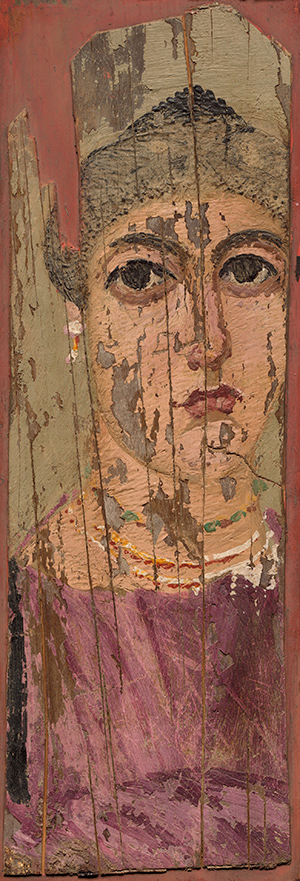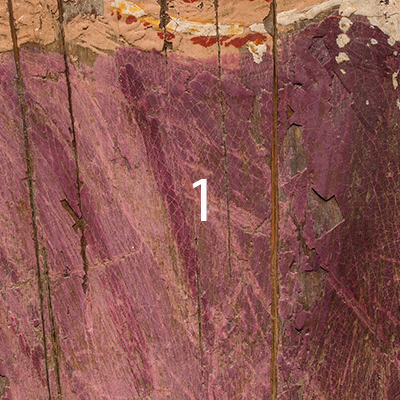Fayum Mummy Portrait of a Woman
ca 2nd century A.D.Paintings sorted by Historical period | Painter | Subject matter | Pigments used

Red Lips
Red ochre, lead white, charcoal black
Red Tunic
Madder lake and chalk
Flesh Tones
Ochres and lead white
Green Beads in the Necklace
Verdigris compounded with bee wax
Eyes and hair
Charcoal black
Yellow Beads in the Necklace
Yellow ochre
Red Beads in the Necklace
Red ochre
Background
Ochres, lead white and charcoal black
Pigment analysis: hover the mouse over the white points to learn about the pigments used at this spot.
Overview
Fayum Mummy Portrait of a Woman
Medium: Encaustic
Support: Wood
Size: 34.6 x 11.5 cm
Art period: Antiquity
National Gallery of Art
Object number: 1956.12.1
Quote from reference (1)
“Greco-Roman portraits are also known as ‘Fayum portraits’ or ‘Romano-Egyptian portraits’, and they are the oldest surviving portrait-paintings, mainly crafted on wooden supports. It is believed to depict images of real people who lived in Egypt during the Ptolemaic (323–30 BC) and the Roman rule (30 BC – fourth century AD). The style is typical of the fashion developed during the Roman Empire in Egypt from the middle of the first century BC to the early fourth century AD reflecting the Greek culture, education, and civic life. The panel painting under consideration is a funerary portrait of a noblewoman.
Her high socioeconomic status is denoted by 1) the elegant hairstyle dating to the period of the emperor Trajan of the second century AD; the purple tunic with clavus (a decorative stripe adorning the garment) and extensive jewelry and 2) the exceptional artistry and painterly execution of the painting with a highly-textured surface achieved by mixing the pigments in the binding medium, the blending and juxtaposition of the paint, and the application of the paint using different tools and methods. The woman depicted in this painting is framed by a yellow/green-yellow background, dressed in a purple tunic with a dark clavus on the right (proper) side. The tunic exhibits different shades of purple/red-purple to express shading, indicating a high level of skill in the painting technique. The jewelry consists of a pendant earring and three necklaces, inlaid with what appear to be pearls and gemstones.”
(1) Delaney, John & Dooley, Kathryn & Radpour, Roxanne & Kakoulli, Ioanna. (2017). Macroscale multimodal imaging reveals ancient painting production technology and the vogue in Greco-Roman Egypt. Scientific Reports. 7. 10.1038/s41598-017-15743-5.
Overview
Medium: Encaustic
Support: Wood
Size: 34.6 x 11.5 cm
Art period: Antiquity
National Gallery of Art
Object number: 1956.12.1
Pigment Analysis
Pigment Analysis of This Painting
This pigment analysis is based on the work of scientists at the National Gallery of Art, Washington, and at the University of California, Los Angeles (1).

1 Red tunic: madder lake and chalk
2 Flesh tones: ochres, lead white
3 Red lips: red ochre, lead white, and charcoal black
4 Eyes and hair: charcoal black

5 Green beads in the necklace: verdigris compounded with bee wax used in the encaustic technique.
6 Yellow beads in the necklace: yellow ochre
7 Red beads in the necklace: red ochre

8 Background: ochres, charcoal black, and lead white

References
(1) Delaney, John & Dooley, Kathryn & Radpour, Roxanne & Kakoulli, Ioanna. (2017). Macroscale multimodal imaging reveals ancient painting production technology and the vogue in Greco-Roman Egypt. Scientific Reports. 7. 10.1038/s41598-017-15743-5.
Pigments Used in This Painting
Resources
Videos
Video: 'The Fayum Portraits: Funerary Painting of Roman Egypt' by The Met
Video: 'Roman Mummy Portraits - Dr. Michael Birrell' by Perth RAG
Publications and Websites
Publications
(1) Delaney, John & Dooley, Kathryn & Radpour, Roxanne & Kakoulli, Ioanna. (2017). Macroscale multimodal imaging reveals ancient painting production technology and the vogue in Greco-Roman Egypt. Scientific Reports. 7. 10.1038/s41598-017-15743-5.
(2) Katz, Brigit. “How 21st-Century Technology is Shedding Light on a 2nd-Century Egyptian Painting.” Smithsonian.com (26 December 2017)









